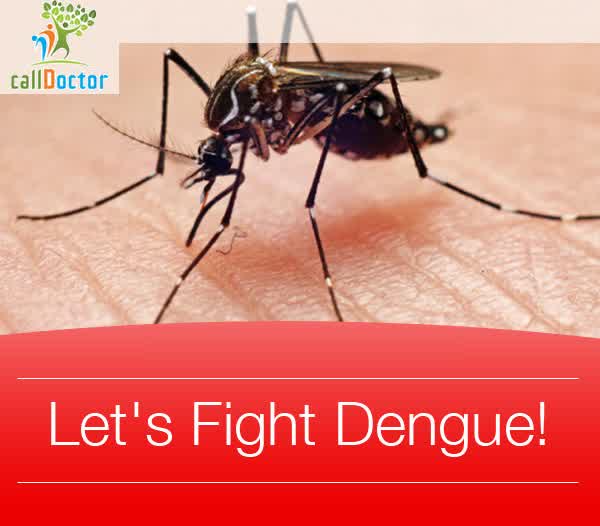Consists of four dengue virus types (strains), ie, dengue type 1, 2, 3 and 4. However, the dominant type in Indonesia are type 3 dengue virus causes disturbances in capillary blood vessels and blood clotting system that cause bleeding, can cause death ,Usually, the dengue fever outbreak when the season is changing from rainy season to dry season, or vice versa.
 |
Symptoms of dengue disease until now it was not unexpected. But in general, this disease has a characteristic such as high heat, dizziness, even vomiting blood. But unfortunately, the same symptoms often found in other diseases. As a result, until now often misdiagnosed. Therefore, you should be more vigilant and recognize other symptoms.
Read More: Causes And Liver Disease Fatty Symptoms
Symptoms of Dengue Fever
1. Sudden high heat for 2-7 days, looked limp body temperature between 38ºC to 40ºC or more.
2. Looks bint-red spots on the skin, and if stretched skin rash that does not disappear.
3. Sometimes the bleeding in the nose (nosebleeds).
4. There may be vomiting blood or dysentery
5. torniquet test positive
6. The presence of bleeding petechiae, or purpura akimosis
7. Sometimes heartburn, because there is bleeding in the barn
8. When severe, the patient anxiety, the end of the cold hands and feet Sweating mucosal bleeding mucous membranes, gastrointestinal digestive apparatus, the injection site or other place
9. Haematemesis or melena
10. Thrombocytopenia (= 100,000 per mm3)
11. Enlargement plasma closely related with the increase in permeability of the blood vessel wall, which is marked by the emergence of one or more of the following:
- The increase in hematocrit value of 20% or more depending on the age and sex
- The decline in hematocrit from baseline of 20% or more after treatment
- Signs of plasma enlargement namely pleural effusion, ascites, hypo -proteinaemia
First Aid Patients with Dengue
Dr Rita explained in handling dengue cases just need to play with a liquid, the event of leakage must be a lot of drinking, but when the leak is complete then within 2 × 24 hours of fluid intake should be reduced.
Here are some things you can do as a form of first aid to patients with dengue fever are:
- Give drink as much as possible.
- Compress so that the heat down.
- Give febrifuge.
- If within 3 days of fever did not go down or even increased immediately brought to the hospital or clinic.
- If you can not drink or persistent vomiting, kondiai worsens, decreased consciousness or missing then it should be treated in hospital.
Read More: Signs of Alzheimer's Disease Symptoms
Modes of Transmission of Dengue
Dengue is transmitted by the bite of Aedes aegypti containing dengue virus.
- The characteristics of the mosquito Aedes aegypti:
- Black and striped belang- (camouflage) and white on the entire body
- Breeding in water reservoirs (TPA) and items that allow stagnant water such as: Bathtub, jars, drums, flower vases, old tires, etc.
- Aedes Aegypti mosquitoes can not breed in gutters / drains or ponds where the water is directly related to land
- Usually bite humans in the morning or late afternoon
- Being able to fly up to 100 meters
When people find a family member or neighbor in an environment with symptoms that indicate the presence of dengue, was immediately taken to the health center for examination platelets.
How to Prevention, Treatment and Handling
How prevention is done by:
1. Eradication
Mosquito eradication nest by the way; Drain, close, burying thrift can become breeding places of mosquitoes.
2. Fogging or fumigation
Foging implemented in cases with positive PE, 2 positive patients or more, found three patients with fever within a radius of 100 m from the residence of DHF patients Positive or No 1 DHF patients died
3. Abatisasi
That is by sprinkling abate powder into the bath or water reservoirs.
4. The early warning system
Reports disease patients from the hospital were sent to the health center in the region of the patient to do an epidemiological investigation.
Treatment of the disease is primarily intended to overcome the bleeding, prevent / treat shock / presyok to try to get people to drink a lot, when necessary fluids through an IV. Fever cultivated lowered by cold compresses or antipiretika.
How to handle dengue patients, among others:
- Monitor the patient's body temperature every day
- Take the patient back to the doctor if the fever lasts 3 days
- Rest and adequate fluid intake is two things that are very important in patients with dengue virus infection.
- If the patient is getting weak, vomiting, difficulty eating or drinking, intravenous fluids should be done by a doctor.
- When laboratory results show no signs of decreased platelets or increased hematocrit, the patient must be hospitalized.
- Patients are monitored should be no shock that is characterized by a sense of weakness, drowsiness, and fainting, while the legs feel cold at all.
Now this is a transition from the rainy season to the dry season when dengue mosquitoes were breeding. Therefore, good understanding of the symptoms of dengue fever is beneficial to prevent outbreaks of this disease.
Tag: Symptoms of Dengue Hemorrhagic Fever And First Aid,pathophysiology of dengue hemorrhagic fever,dengue hemorrhagic fever treatment,dengue hemorrhagic fever criteria,dengue hemorrhagic fever grading,dengue hemorrhagic fever ppt,dengue hemorrhagic fever pdf,dengue hemorrhagic fever definition,dengue hemorrhagic fever case study
Hopefully the above post titled Symptoms of Dengue Hemorrhagic Fever And First Aid can be useful for you all with some information about the signs of bronchitis above. And if deign try to share this article to your friends on facebook or other social media.

No comments:
Post a Comment